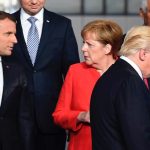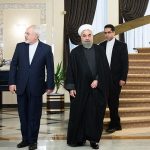by Djavad Salehi-Isfahani
Last April, in a column for this blog I predicted that sanctions are very unlikely to force Iran to renegotiate the multilateral nuclear deal known as the Joint Comprehensive Plan of Action (JCPOA). In particular, I argued that the belief held by Iran hawks in Washington foreign policy circles, that economic pressure will eventually force Iran to the negotiating table, exaggerated the importance of oil exports for Iran’s economy.
New data indicate that, while Donald Trump’s policy of “maximum pressure” has reduced Iranian oil exports to near zero and seriously hurt Iran’s economy, it has not caused anything resembling economic collapse. Furthermore, these data suggest that the economy is not in a steep decline, one that would anytime soon force Iran to capitulate.
The national accounts data, published by the Statistical Center of Iran (SCI), indicate that, in the Iranian year 2018/19 (21 March 2018 to 20 March 2019), GDP declined by 4.9 percent, which is far from a collapse of output. Coming after two years of robust growth following the July 2015 nuclear deal, it puts the economy still above its 2015 level.
This decline was, not surprisingly, led by the oil sector, which fell by 14 percent, followed by manufacturing (6.5 percent), which depends on imports of parts, and construction (4.5 percent). However, non-oil GDP, which measures the level of domestic economic activity, fell by only 2.4 percent. This is because output in services, which accounts for 55 percent of Iran’s non-oil GDP, remained unchanged, and agriculture, accounting for another 10 percent, fell by 1.5 percent.
Iran’s economy has taken a beating, but it is not a disaster, as President Trump likes to describe it. To most Iranians, his remarks last September—which he repeated in June—that Iranians “can’t buy bread,” showed how out of touch he is with the consequences of his own policy. Travelers to Iran have noticed, as I did this summer, that supermarkets shelves were full (though mostly with home produced goods at high prices), and there were no lines in government distribution centers, which are the hallmark of real disaster economies, like Venezuela.
High prices, triggered by the tripling in the value of the U.S. dollar since early 2018, have taken their toll on household incomes. The most recent SCI survey of income and expenditures shows that in 2018/19 average real incomes per capita fell by 6.7 percent in urban areas and 9.1 percent in rural areas, more than the decline in GDP per capita. These are sharp drops, but obviously not enough to ignite urban protests, as the Trump administration had hoped.
Going forward, the question is whether the Iranian economy is on a steep decline, is stabilizing at a lower level, or is on the road to recovery. This will influence Iran’s willingness, or lack thereof, to negotiate with the U.S., and should matter for Washington as it evaluates its Iran policy in light of its failure so far to yield the desired results. As always, Iran hawks recommend staying the course with “maximum pressure,” believing that Iran will “ultimately do a 180 if they perceive that there’s no way out.”
But what if there is a way out? What if Iran can restructure its economy to become less dependent on imports and truck along with reduced oil exports? Iranian leaders may be pinning their hopes on this scenario and thinking that the worst is over when they flatly reject negotiations.
In this belief they can draw support from the International Monetary Fund (IMF). In its April 2019 World Economic Outlook, the IMF predicted that negative economic growth in Iran will end in 2020 and positive growth of around 1 percent per year will prevail till 2024. Not a rosy scenario by any means, as it implies loss of economic growth and declining per capita incomes for the foreseeable future, but it may be enough to convince Iranian leaders not to capitulate.
IMF forecasts beyond a year do not always materialize, and we do not know their assumptions about when U.S. sanctions will end. But the latest evidence from Iran’s labor force survey suggests that an end to the recession may be in sight. They show that in spring 2019, compared to spring 2018 before sanctions came back in full force, employment increased by 324,000 and the number unemployed fell by 365,000. As a result, the unemployment rate fell to a five-year low of 10.8 percent.
Significantly, half of this increase in employment was in industry, the sector that is most exposed to sanctions because its production depends on imports of intermediate inputs. Nearly half of all Iranian imports are intermediate goods.
Cynics have reason to doubt official Iranian surveys, but the rise in employment reported by the SCI makes good economic sense. For over a year, Iran’s currency has been at a historic low and its labor costs the cheapest in memory (about $5 per day for unskilled labor, half that in China). With rising profitability, it makes perfect sense for businesses to increase hiring to fill in for lost imports.
But the switch to local production faces two obstacles. First, the U.S. sanctions themselves. To sustain the structural adjustment needed to reconfigure industrial production requires access to global markets, which trade sanctions inhibit. Second, it requires a banking system to finance businesses to restructure. Iran’s banking system is too weak to do so at present.
While the prospects of economic recovery remain uncertain, it is safe to reject the assumption that Iran’s economy is on a “death spiral,” to use a favorite phrase of Iran hawks. While economic conditions are desperate for many Iranians in need of jobs and medicine, they are not desperate enough for Iran’s leaders to risk getting into a costly war with their southern neighbors and the U.S. just to end the current stalemate. Iran’s Supreme Leader, Ayatollah Ali Khamenei, who has ruled out negotiations with Trump, is for one interested in finding out if the economy will rise to the challenge of sanctions and thus become the “resistance economy” that he has advocated for years.






People might take Iran seriously if it stopped arresting foreign female tourists.
Bunch of cowards.
Tradingeconomics states that the inflation doubled to over 50% in the Spring this year and has pulled back a bit. That is nuts. The stock market is doing very well. The Rial is stable for now. Most of this all because Iran has been effectively put under lockdown. How long this false economy will last? And then you have the other economy of Iran which some would say is the real economy.
Meanwhile the US shale oil boom threatens to bust, which would increase demand from elsewhere.
Thank you Professor Salehi-Isfahani for your realistic reporting of Iran economy in the past and present time.
BBM,
Irrelevant!
Iran much like any other country has the legal rights to arrest, prosecute and punish those who are spying on that country especially if the spying is done by Israel and the West. It doesn’t matter if the spies are male or female.
Official statistical data are often manipulated to cover up mismanagement; they can hardly reflect the reality they purport to.
How can employment go up while millions are struggling to survive and 1000s upon 1000s haven’t been paid their salaries for months and in response to their protests they are mercilessly beaten up and thrown into prison. Many families cannot afford to send their children to school because of being unemployed and cannot afford to buy stationary! Desperate for job many have turned to crimes and drugs and prostitution in order to survive.
You are as much out of touch with the reality of our lives that Trump and many Iranian and Western qualified “Iran experts” and many expatriate Irsnian commenters are.
Your article is a worthless piece of propaganda, and your close observations of supermarkets in Iran (very likely to have been in wealthy areas) and of the prices while on holiday (with your foreign currencies) are an insult to the suffering of millions of iranians!
Shame on you.